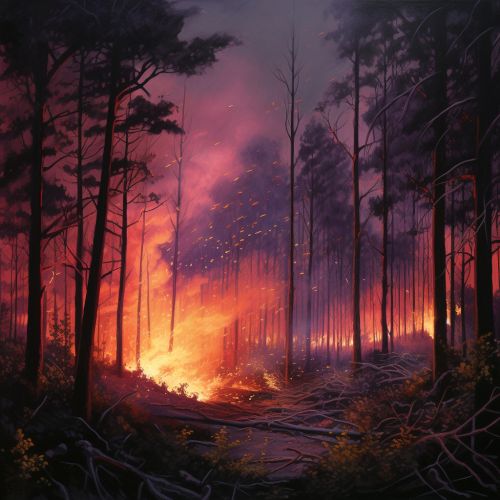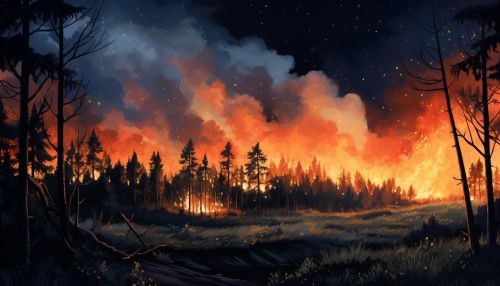Climate Change and Wildfires
Introduction
Climate change and wildfires are two interconnected phenomena that have been the subject of extensive scientific research. Climate change, a long-term shift in global or regional climate patterns, is primarily attributed to the increased levels of atmospheric carbon dioxide produced by the use of fossil fuels. This change in climate has a direct impact on the frequency, intensity, and duration of wildfires, which are uncontrolled fires spreading across vegetation and forest areas.
Climate Change: An Overview
Climate change refers to significant changes in global temperatures and weather patterns over time. While climate change is a natural phenomenon, scientific evidence shows that human activities have greatly accelerated the rate of change since the Industrial Revolution. This period marked a significant increase in the use of fossil fuels, leading to a substantial rise in the emission of greenhouse gases, particularly carbon dioxide and methane.
The greenhouse effect, a natural process where certain gases in the Earth's atmosphere trap heat from the sun, is essential for supporting life on Earth. However, the increased concentration of these gases due to human activities has enhanced the greenhouse effect, causing the Earth's average temperature to rise—a phenomenon known as global warming.


Wildfires: An Overview
Wildfires, also known as forest fires, bushfires, or vegetation fires, are uncontrolled fires that rapidly spread across vegetation and forest areas. They can occur in almost any terrestrial ecosystem, from the grasslands of the African savannah to the forests of North America. Wildfires are typically caused by human activities such as deforestation, land clearing, and arson, but can also be sparked by natural phenomena like lightning strikes.
Wildfires play a crucial role in shaping ecosystems and promoting biodiversity. For instance, some plant species have adapted to survive, and even thrive, following wildfires. However, when wildfires occur too frequently or burn too intensely, they can cause significant ecological damage and pose a threat to human life and property.
The Link Between Climate Change and Wildfires
There is a growing body of scientific evidence that links climate change to an increase in the frequency and intensity of wildfires. Rising global temperatures, one of the most direct effects of climate change, contribute to increased evaporation rates, leading to drier conditions that can exacerbate wildfires.
In addition to creating drier conditions, climate change can also lead to more extreme weather events, including heatwaves and droughts. These conditions can create an environment that is more susceptible to wildfires. For example, prolonged periods of dry and hot weather can dry out vegetation, turning it into 'fuel' that can easily ignite and spread wildfires.
Furthermore, climate change can disrupt normal weather patterns, leading to changes in the timing and amount of rainfall. This can result in longer wildfire seasons and more severe wildfires. For instance, in regions where rainfall is reduced or delayed, vegetation and soils can become excessively dry, increasing the likelihood of wildfires.
Impact of Wildfires on Climate Change
While climate change contributes to the conditions that can lead to wildfires, the relationship between the two is complex and bidirectional. Wildfires can also exacerbate climate change by releasing large amounts of carbon dioxide and other greenhouse gases into the atmosphere. When vegetation burns, the carbon stored within it is released back into the atmosphere, contributing to the greenhouse effect and further global warming.
Moreover, wildfires can have a significant impact on the Earth's albedo—the fraction of solar energy reflected back into space. When forests burn, the land that was once covered by dark, light-absorbing trees becomes a lighter, more reflective surface. This change in albedo can affect the Earth's energy balance and contribute to climate change.
Mitigation and Adaptation Strategies
Given the strong link between climate change and wildfires, addressing one can have significant implications for the other. Mitigation strategies aimed at reducing greenhouse gas emissions can help slow down climate change and, in turn, potentially reduce the severity and frequency of wildfires.
Adaptation strategies, on the other hand, focus on adjusting to the changing climate and minimizing the risks associated with wildfires. This can involve improving fire management practices, developing early warning systems, and implementing land-use planning measures to reduce the vulnerability of communities to wildfires.
Conclusion
The relationship between climate change and wildfires is complex and multifaceted. While climate change can create conditions that promote wildfires, these fires can also exacerbate climate change by releasing additional greenhouse gases into the atmosphere. Understanding this relationship is crucial for developing effective strategies to mitigate the impacts of both climate change and wildfires.
